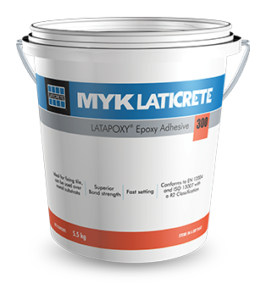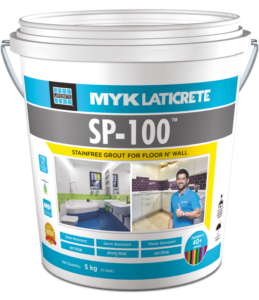LATAPOXY® 300 EPOXY ADHESIVE is a high strength 100% solid epoxy adhesive, highly suitable for chemical resistant installation of quarry tile, brick and pavers on internal floors of food processing plants, commercial plants, commercial kitchens and beverage plants. Ideal for installing moisture sensitive marbles, it can be used on all metals, including copper.
Material Safety Data LATAPOXY 300 PART A
Material Safety Data LATAPOXY 300 PART B
Features & Benefits
- Ideal for fixing tiles, can be used over metal substrate
- Superior bond strength
- Fast setting
Product Details
 Coverage
Varies in accordance with the size and type of the tile and stone installed
Color
Grey & White
Certification
Coverage
Varies in accordance with the size and type of the tile and stone installed
Color
Grey & White
Certification
- EN 12004/ISO 13007:R2T
- IS 15477 : 2019 : TYPE 5 T
- VOC : Very Low
How to apply
- Ensure the substrate is clean and free from impurities like dust, dirt, debris, oil, grease, curing agents, loose plaster etc.
- Clean the back of tile for any dust or coating
- Clean & dampen the surface and remove the excess water. Let the substrate dry completely before applying the adhesive.
- Ensure the area is shaded from sunlight. The adhesive shall be applied with the flat side of the trowel using a scraping motion to work the material into good contact with the surface to be covered.
- Additional mortar is then applied with the notched edge of the trowel.
- When installing large tiles, spread adhesive onto back of tile in addition to troweling material over a surface to be tiled. Select proper type of notched trowel.
a) Thin Tiles upto size 300 X 300 mm (1’X1’), use a square notched trowel of size 6mm X 6mm to provide a total thickness of 3mm
b) Large Porcelain Tiles upto 450 X 450 mm with ribs, use a square notched trowel of size 6mm X 6mm and back butter the tiles with the same adhesive to a thickness of 1-1.5mm to provide a total thickness of 4.5mm
c) Large Porcelain Tiles upto 600 X 600 mm (2’X2’) with ribs, use a square notched trowel of size 6mm X 9mm and back butter the tiles with the same adhesive to a thickness of 1-1.5mm to provide a total thickness of 6mm
- The most important standard to keep in mind is to ensure that the piece of tile is completely bedded in the mortar or adhesive with 100% coverage.
- The joints between two metal sheets must be brought through to the surface of tile. At no point of time the adhesive should enter the joint between two metal sheets.
- Rear face of tiles (especially Porcelain tiles) should be cleaned with the damp sponge to clean all the dust. Do not saturate in water.
- Excess mortar on adhesive shall be cleaned from the surface of the tile with wet cloth or sponge while the mortar is fresh.
- Resin-backed Tiles
- Mosaics
- Stone
- Agglomerates


